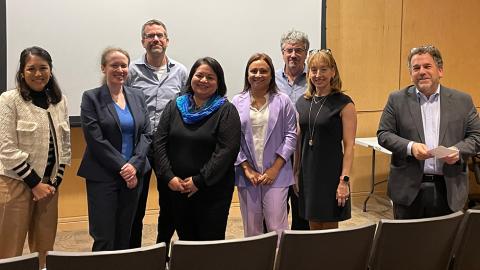Researchers from across the globe join together for a day-long symposium on autism and rare genetic diseases

When someone we care about falls ill, not knowing the cause of their ailment or how to treat their condition can be a frightening, exhausting experience. This is especially true for those suffering from rare genetic diseases and complex conditions like autism where research that begins at the bench and in the lab often moves to the bedside at an incremental rate.
On Monday, October 16th, researchers, clinicians and scientists from across the globe came together at Brown University for the CTN Symposium on Autism and Rare Genetic Diseases; a day-long, event to address key questions and current concerns surrounding autism spectrum disorder (ASD) and other neurodevelopmental genetic disorders. Organized by the Center for Translational Neuroscience, a collaborative center between the Carney Institute for Brain Science and the Division of Biology and Medicine, speakers discussed methodologies for advancing translational neurodevelopmental research including novel research techniques including human and animal model studies, paths from bench-to-bedside, and key challenges for developing new therapies.
“Childhood development disabilities such as autism are incredibly common. One in six children have a developmental disability,” said Mukesh Jain, Dean of Medicine and Biological Sciences at Brown, who welcomed symposium participants and audience members. “There’s no doubt that a lot more work needs to be done in this space. And there is hope around the corner by harnessing genetics, new advances in gene, cell and nucleic acid therapeutics but we’re not yet where any of us want to be.”
The CDC’s Autism and Developmental Disabilities Monitoring (ADDM) Network estimates that an average of 1 in every 36 (2.8%) 8-year-old children have autism spectrum disorder (ASD) in 2020. Rare diseases — defined by the Orphan Drug Act as a disease or condition that impacts fewer than 200,000 people in the U.S.— affect about 1 in 10 people (or 30 million people) in the U.S. according to the NIH’s Genetic and Rare Disease Information Center (GARD).
“At Brown, we’re committed to the critical need for progress in this space, and in this regard, I want to really applaud…the Center for Translational Neuroscience — a center that synergizes the mission of the Carney Institute for Brain Science and the Division of Biology and Medicine to have an ambitious effort to try and tackle these kinds of challenges,” said Jain. “The center really exemplifies rather beautifully the bench to bedside and, in many cases, the bedside to bench and back effort…for facilitating translational neuroscience at Brown.”
Addressing a packed room of grad students, researchers and scientists, the six invited speakers spoke in depth about the cutting-edge methods being used to investigate these neurodevelopmental disorders including novel phenotyping approaches using computer vision and artificial intelligence, identifying the molecular signatures that modulate morphogenesis and synaptic function, and employing gene and molecular therapies such as the use of CRISPR-edited induced pluripotent stem cells.
Several speakers underlined the importance of including family members of those living with autism and rare disorders throughout the research process. “My lab works on profound autism and intellectual disability. All the projects in my lab started working with families. It’s an honor to work with these families who at some point in the odyssey with their loved one discovered that they had a rare genetic disorder,” said Brown University professor Eric Morrow, a member of the symposium organizing committee. “The genetic diagnosis..., to say it plain and clear, in my experience with these families is meaningful. To scientists, it’s a particularly excellent way to organize a powerful way of dissecting the basic science as well as contributing to diagnosis, and potential treatments.”
The full list of speakers included Silvia De Rubeis, Ph.D., from the Icahn School of Medicine at Mount Sinai; Ilan Dinstein, PH.D., from the Ben-Gurion University of the Negev; Ellen Hoffman, Ph.D., from Yale School of Medicine, Eric Levine, Ph.D, from University of Connecticut School of Medicine; organizing committee member Sofia Lizarraga, Ph.D., from Brown University; and organizing committee member Eric Morrow, Ph.D., from Brown University. Joining the panel discussion were Alison Singer, from the Autism Science Foundation, and Pam Feliciano, Ph.D., from the Simons Foundation for autism research. Among the meeting speakers and panelists were parents and family-members of those with autism and developmental disabilities.
“Having this international body of researchers in one space, openly sharing their work and interacting with the audience is invaluable,” said assistant professor and lead symposium organizing committee member Sofia Lizarraga. “It’s in settings like these where we chart the course for future research collaborations where breakthroughs in autism and rare genetic diseases are made.”
You can read more about the speakers and panelists, their research and the Center for Translational Neuroscience here.



